
by Nabeela | Dec 17, 2022 | IELTS
The IELTS reading section is one of the four sections tested during the English language proficiency exam. It assesses a candidate’s ability to interpret, analyze and evaluate written text. The tasks are designed to reflect real-life scenarios that students may encounter in an academic context.
The reading section consists of three passages with accompanying questions. The passages are generally taken from books, magazines, newspapers and journals on a variety of topics. Each passage is followed by questions that test the candidate’s comprehension of the text. The questions may range from finding specific details to interpreting an argument or analyzing a tone.
Time management is key in this section as candidates only have one hour to complete the entire test. In addition, candidates should be mindful of how much time they spend on each passage and question to maximize their scores.
To prepare for this section, students must become familiar with the types of passages used in the IELTS reading test. Practicing past questions can also help students get used to the structure and types of questions they may encounter. Finally, developing a good reading speed is essential to complete the test within the allotted time frame. With practice and patience, candidates can master this section.
5 Tips to improve your IELTS Reading Section
Acing the IELTS reading section may seem like a daunting task, but with practice and dedication, it’s possible to ace it! Here are five tips that will help you get the best score possible on your IELTS Reading Test:
Understand Question Types
It is important to read the instructions for each question carefully before starting so that you can understand the type of question being asked. The IELTS Reading Test consists of three different types of questions: True/False/Not Given, Matching Headings, and Multiple Choice. Each of these question types requires a different approach when answering and so it’s essential to be aware of their differences.
Read Carefully
When answering any reading questions, pay close attention to detail and read each sentence thoroughly. Look for facts, dates and places as they will give clues to the right answer, as well as any keywords that might help you answer the specific question type being asked.
Skim for Keywords
Once you have read the instructions for a particular question, quickly scan through the passage looking for keywords related to this topic. This makes it easier to locate relevant information faster than if you were to read every single line in search of answers or explanations.
Answer What You Know First
If you find yourself stuck on a difficult or unfamiliar question, start by answering what you know first then move step by step until you reach your destination answer. This allows you to build upon small successes rather than getting overwhelmed with an entire passage at once.
Practice Makes Perfect
As mentioned earlier, practice does make perfect when it comes to acing your IELTS Reading Section test! Take time out of each day or week dedicated solely towards studying different types of questions and passages so that when test day arrives; you’ll feel confident and prepared! Try testing yourself with mock exams or finding sample papers online – both are great ways to sharpen your skillset!
By following these tips closely and dedicating time towards studying for your reading section test you will be sure to get the best score possible! Remember that anything is possible with enough practice and determination – So reach out – we’d love to help you achieve your language goals! Best of luck – we know you’ll ace it!

by Vishal | Dec 17, 2022 | Admissions counselling, IELTS, study abroad, Test
The International English Language Testing System (IELTS) writing section consist two tasks. Task 1 requires test takers to write a report based on information provided in a diagram, chart, or table. This task type typically lasts for 20 minutes and is worth one-third of the total score. Task 2 requires test takers to write an essay in response to a given issue or topic. This task type typically lasts for 40 minutes and is worth two-thirds of the total score. For the success of the 2 tasks we need to improve your IELTS writing skills.
Preparing for the IELTS Writing Section: Tips to Take Your Essay to the Next Level
Writing an essay for IELTS exam can be a stressful, but with some strategies, you can additionally craft an amazing piece of content that will impress the examiners and help you get the score you need. Here are some tips to make sure your essay is as successful as possible.
Plan Ahead
Creating an excellent essay takes time and effort – it’s important to make sure your work is well-paced and persuasive. Before jumping into the writing process, plan ahead by creating an outline of your argument. This will help you structure your points, identify any holes in your research, and decide how to transition between topics. Having a plan will help you stay organized and make it easy to access your research when needed. With just a little bit of advanced preparation, you can set yourself up for success!
Spice Up Your Language
To make sure your message is heard and understood by all readers, try using different language structures to express yourself. This will help you tell your story more vividly and add color to your communication. And don’t be afraid to experiment! This can Improve IELTS writing skills.
Logic Matters
One way to make your ideas flow better when writing is by creating a ‘map’ or outline beforehand. This can be done in many ways, as long as it helps you organize information into tables or graphs for easier reading. Once you’ve arranged everything in a logical order, it’s time to start writing!
Accuracy Matters Too
Although often overlooked in our haste to finish our work quickly, checking for accuracy – such as spelling, grammar and punctuation – is critical for ensuring that the written communication we produce is clear and easy-to-understand for all readers. Taking those few extra minutes at the end of each sentence or word choice may seem tedious but it really pays off in terms of making sure that every detail is perfect – think of it as adding icing on top of a beautiful cake!
sections !
Confidence and skill improvement
With these tips in mind, you’ll have no problem tackling the essay for IELTS with confidence! And of course if nerves are still getting in the way of you achieving success on this important exam then don’t hesitate asking us about our tutoring services which help boost both skillset and self-assurance levels prior taking any formal test. We’re here to help guide students towards their language goals every step of the way! Good luck – we know you’ll completely ace it! Keep in mind the tips we’ve discussed in this blog post and you’ll be well on your way to getting the score you need. And if you’re still feeling unsure about taking the IELTS, remember that we offer tutoring services to help you boost your skills and confidence. So don’t hesitate to reach out – we’d love to help you achieve your language goals! Best of luck!
Now that you’ve got these strategies and tips in mind, it’s time to get writing! With proper preparation, practice, and a little bit of patience, there’s no doubt that you can successfully ace the IELTS writing section and pass with flying colors. Good luck!
We wish you all the best of luck on your upcoming IELTS exam! Don’t forget to use these strategies and tips when you’re crafting your essay – they’ll help you impress the examiners and get that score you need. And remember, we’re here to offer our tutoring services if nerves or any other issue gets in your way. So reach out – we’d love to help you achieve your language goals! Best of luck – we know you’ll ace it!
For more information visit
https://www.ielts.org/
by Labhesh | Nov 24, 2020 | Admissions counselling, IELTS, Motivation, study abroad, Test
On the off chance that you are taking IELTS to concentrate abroad, at that point you will take the Academic IELTS Reading Module. So read the Format of The IELTS Reading Test.
In the event that you are taking IELTS for different purposes, for example, working abroad, at that point you will take the General Training Reading Module.
In any case, improving your reading for IELTS is significant as you will confront some intricate reading and troublesome jargon.

Module of IELTS Reading
About the Reading Test
Both IELTS Reading Tests, Academic and General Training, expect to evaluate the accompanying aptitudes:
- Reading for gist
- Reading for main ideas
- Reading for detail
- Understanding inferences and suggested meaning
- Recognising a scholar’s suppositions
- Attitudes and reason
- Following the improvement of an argument
The tests change in their substance:
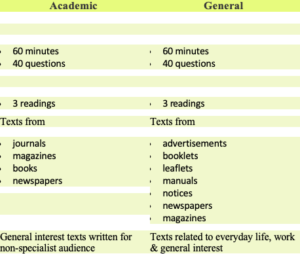
Format of The IELTS Reading Test
The Academic IELTS Reading Module
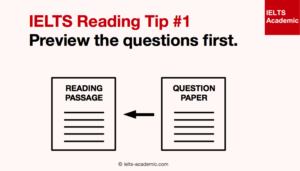
follow this pattern
The Academic IELTS Reading Module takes an hour and there are 40 questions to reply. Each question is worth 1 mark.
The Reading Passages
There are three reading passages with an aggregate of 2,150-2,750 words. Writings are taken from diaries, magazines, books, and papers.
All the points are of general intrigue and the writings have been composed for a non-specialist audience. The readings are planned to be about issues that are proper to competitors who will enter postgraduate or college classes.
In any event one content will contain definite legitimate argument. One of the writings may contain non-verbal materials, for example, charts, outlines or graphs.
On the off chance that there are specialized terms which you may not know in the content then a glossary is given. The writings and questions become more troublesome through the paper.
The Questions
Guidelines are clear and simple to follow and you will be given instances of any new question types. Messages and questions show up on a Question Paper which you can compose on however not detract from the test room.
You should address all questions on an Answer Sheet during the hour – there isn’t additional time toward the conclusion to move your responses to an answer sheet.
The position of the question changes- a portion of the inquiries may precede an entry, some may come in the wake of, depending on the question type.
These are the sorts of question you can hope to find in the test:
- short-answer questions
- multiple decision
- sentence culmination
- notes/outline/graph/stream diagram/table culmination
- choosing a heading for a section
- identification of author’s perspectives/claims – truly, no or not given
- identification of data – true, false or not given
- classification
- matching records/phrases.
There is an answer sheet and you should enter all the questions on there during the test. There is no additional time toward the conclusion to enter the scores. So read the tips of IELTS Reading Test.
Refer to the Format of IELTS Listening Test.
by Labhesh | Nov 23, 2020 | Admissions counselling, IELTS, Motivation, study abroad, Test
Read this following article to Know the Format of IELTS Listening Test and also refer to the tips and format for IELTS Writing Test.

Know the Format of IELTS Listening Test
The listening module endures 40 minutes – 30 minutes listening and 10 minutes to add your responses to an answer sheet. There are 4 areas, each one getting more difficult.
The initial two sections of the test are worried about social needs.
The last two sections are worried about circumstances related all the more near education and training contexts.
All the IELTS listening topics are of general interest and it has no effect what subjects you are wanting to consider or what work you plan to do.
A scope of English pronunciations and vernaculars are utilised in the recordings which mirrors the worldwide use of IELTS
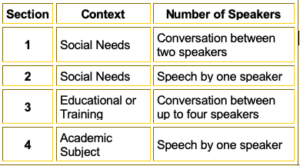
Format in brief
Section One
In the primary segment there is a discussion between two speakers. For instance – a discussion about travel arrangements, booking convenience, or choices on a night out.
Section Two
The subsequent section is a monologue (a discourse by one individual). It will be set in an ordinary social setting. For instance – a discourse about student administrations on a University grounds or plans for suppers during a gathering.
Section Three
Section three is a discussion between up to four individuals. For instance – a discussion between a coach and a student about a task or between three students arranging a research project
Section Four
The last part is another monologue. It is a lecture or talk of general academic interest such as a university lecture.
Question Types
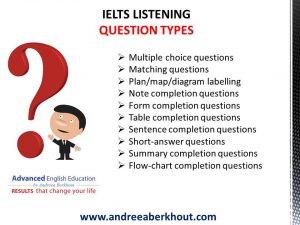
question types
The accompanying sorts of inquiry may show up on the test:
- multiple decision
- short-answer questions
- sentence finish
- notes/rundown/graph/stream outline/table fruition
- labelling a graph which has numbered parts
- classification
- matching
You will be given guidelines on the test paper on the most proficient method to respond to the questions, and they are clear and simple to follow. You will be given instances of any unfamiliar question types.
During the IELTS listening test, you are offered time to read the questions and enter and then check your answers. You enter your answers on the question paper as you listen and when the tape closes ten minutes are took into consideration you to move your responses to an Answer Sheet.
One mark is granted for every one of the 40 things in the test. So to get a perfect score, read the tips for IELTS Listening Test.
by Labhesh | Nov 20, 2020 | Admissions counselling, IELTS, Motivation, study abroad, Test
The IELTS test position additionally changes among Academic and General Training for the Writing Test. Refer to the Tips and Format for IELTS Writing Test mentioned below. Also, know the Format of IELTS Speaking Test.
Format for IELTS Writing Test

get equipped with IELTS Writing Test format
Academic
There is a Task 1 and a Task 2. The test time is an hour. It is prescribed in the test to go through 20 minutes on task 1, as it is worth less marks, and 40 minutes on task 2.
- Task 1 is depicting a chart, outline, process or map.
- Task 2 is composing an academic essay on a subject of general interest.
General Training
Again, there is an undertaking 1 and an assignment 2, with a total test time of an hour, and a suggestion to go through 20 minutes on task 1 and 40 minutes on task 2.
-
Task 1 is composing a letter to somebody, either casual, for example, a companion, or more formal, for example, an organization director, on a given topic.
-
Task 2 is composing an academic essay on a subject of general interest.
Tips:

tips to tackle IELTS Writing section
Do IELTS Writing Task 2 First

complete writing task 2 before task 1
Since IELTS Writing Task 2 is the equivalent on both the Academic and General tests, many think that its simpler than Task 1 (particularly authors of the Academic test). The other significant preferred advantage Task 2 has is that it’s worth a greater mark than Task 1. Obviously, it likewise takes more time to finish. Consequently, it’s ideal to not just dedicate most of your chance to Task 2 yet to finish it first.
You would prefer not to stall out on Task 1 and just leave yourself 20 minutes to wildly compose something for Task 2. IELTS suggests going through 40 minutes on Task 2 and around 20 minutes on Task 1. This is a decent rule obviously; your own experience may vary. Try not to get too worried about adhering to these specific time limits – simply ensure you don’t give more opportunity to Task 1 than you have to.
Avoid Informal Writing

tips to avoid informal writing
This tip applies basically to the Academic test, yet it’s critical to remember for the General test too. While your answers don’t need to be in formal style on the General test, it’s ideal to keep away from certain casual composing rehearses. For example, abstain from utilizing shortenings – write out the full word. Likewise try not to write in the first or second individual (I, me, you) except if instructed to do as such.
Paraphrase, Don’t Copy

paraphrase the text
You ought to never duplicate any piece of the inquiry into your reactions for either Task 1 or 2. Rather, figure out how to reword. You may need to utilize some portion of the questions in your reactions so as to illustrate a point however on the off chance that you do, ensure you put it into your own words.
Practice, Practice, Practice!

keep practicing
The best way to show signs of improvement at writing is to continue doing it. Take the same number of training tests as you can before the genuine test. Get somebody you know with solid English writing abilities to investigate your answers and offer input.
Hope you now are well equipped with the Tips and Format for IELTS Writing Test.
Nevertheless, to avoid 6 common mistakes that students make in IELTS, refer to the link.
by Labhesh | Nov 19, 2020 | Admissions counselling, IELTS, Motivation, study abroad, Test

Format of IELTS Speaking Test
The IELTS test format is four modules in which you are tested on your speaking, listening, reading, and writing skills.
You have to settle on whether to take the Academic or General Training Test versions.
In light of your outcomes, you are then given a band score between 0-9.
The IELTS test format fluctuates as indicated by why you are stepping through the examination. There are two test versions accessible, Academic or General Training.
They utilize a similar band scales and the two versions survey the four language skills of speaking, listening, reading, and writing.
Academic is for individuals applying for advanced education for example college, or expert enlistment.
General Training is for individuals moving to the UK, Australia, or Canada, or applying for training programs, work experience, or optional instruction in an English-talking condition.
Obviously, the Speaking segment is additionally one which test-takers locate the most overwhelming. They stress over their week vocabulary, familiarity and failure to talk certainly.
The IELTS speaking test is the equivalent for both academic and general training candidates.
You are evaluated by an IELTS analyst in a one-to-one interview which keeps going 11-14 minutes. It is separated into three sections.
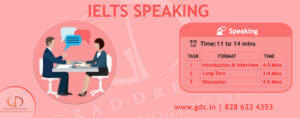
time taken for the speaking test
Before reading the Format, register yourself with Anannt for IELTS Preparation.
IELTS Speaking Test Format

other than speaking, be careful with your gestures
Section One:
You are posed a few inquiries about either your home, old neighbourhood, study or work, and then questions around two different themes haphazardly picked by the examiner. These could be about things, for example, occasions, the climate, visiting galleries, reading, style, travelling and so forth.
Section Two:
You need to represent two minutes on a subject the analyst gives you. For instance, you could chat on an educator you loved, an evening gathering you joined in, or a most loved spot to visit. You are given a pencil and paper and given one moment to set up your discussion.
Section Three:
You have a conversation with the analyst around more unpredictable themes identified with your section two talk. So, for instance on the off chance that you talked about an instructor you enjoyed to a limited extent two, section three could be inquiries regarding the instructive framework in your nation and all the more for the most part.
Know the tips for your IELTS Speaking Test.
Hope the article was useful. If you have any doubt, do comment!!!

















